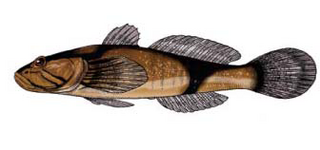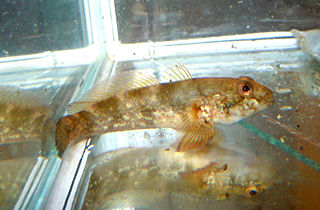
Benthophiloides brauneri is a species of goby, a benthophilic fish native to the fresh and brackish waters of the Black Sea, the Caspian Sea and the Sea of Azov as well as their surrounding rivers and estuaries. Despite the wide distribution, very few observations overall of this fish exist, and just one from the Caspian basin. It has been found in still waters at depths down to around 15 metres (49 ft). Males of this species can reach a length of 7.2 centimetres (2.8 in) SL while females only reach 5.1 centimetres (2.0 in) SL. This fish only lives for one year.

The Syrman goby is a species of goby native to marine, brackish and probably fresh waters of the Black Sea, the Sea of Azov and the Caspian Sea basins. They inhabit inshore waters with substrates composed of shell fragments, sand, mud or muddy sand. This species can reach a length of 24.5 centimetres (9.6 in) TL.

Ponticola is a genus of gobies native mostly to fresh waters of the Black Sea - Caspian Sea region in Eurasia. Some species occur in the brackish-water Black and Caspian seas themselves. It was considered to be part of the broader goby subfamily Benthophilinae, also endemic to the same region, although the 5th edition of Fishes of the World does not list any subfamilies in the Gobiidae. Originally, Ponticola was described as subgenus of Neogobius.

The mushroom goby is a species of goby native to the Black Sea where it can be found along the coasts from Bulgaria to the Crimea. Mostly a species of marine and brackish waters, it is known to enter fresh waters in the delta of the Danube River. This species prefers inshore waters with rocks or fallen trees. This species can reach a length of 20 centimetres (7.9 in) TL.

The stellate tadpole-goby is a species of gobiid fish native to the basin of the Sea of Azov where it occurs in the Gulf of Taganrog and limans of the eastern coast. It also lives in the lower Don River up to the Tsimlyansk Reservoir. It occurs in fresh and brackish waters of depths greater than 3 metres (9.8 ft), preferring shallow coastal lagoons and lowland rivers. Males can reach a length of 13.5 centimetres (5.3 in) TL while females only reach 11 centimetres (4.3 in) TL.

The ratan goby is a species of goby native to brackish and marine waters of the Black Sea, the Sea of Azov and the Caspian Sea. In the Caspian Sea it is presented by subspecies Ponticola ratan goebeli. It occurs in inshore waters, inhabiting areas with stone or gravel substrates. This species can reach a length of 20 centimetres (7.9 in) TL.

The eastern tubenose goby is a species of gobiid fish native to fresh and brackish waters of the basins of the Sea of Azov and the Caspian Sea and has invaded the upper reaches of the Volga River from its native occurrence in the delta. This species prefers slow flowing rivers or still waters with plentiful rocks or vegetation. It can reach a length of 9 centimetres (3.5 in) SL. It is probably the same species as that recently treated as Proterorhinus semipellucidus.
The Caucasian goby is a species of goby native to rivers of the Caucasus draining to the Black Sea in Europe and Asia. This species is strictly a fresh water species and will not enter brackish water. It can reach a length of 20 centimetres (7.9 in) SL.

Ponticola cyrius, the Kura goby, is a species of gobiid fish endemic to the Kura River in the southern Caucasus countries of Georgia, Turkey, Iran and Azerbaijan. It reaches a length of 13 centimetres (5.1 in) SL. It lives in the upper parts of the Kura River, Massuleh River and the Pasikhan River and in the Anzali Mordab (Iran). Downstream in Kura it is replaced by Ponticola gorlap.
Ponticola rizensis is a species of gobiid fish endemic to Turkey where it is known only from the İyidere stream drainage, close to the cities of Rize and Trabzon. The species was described as new to science in 2008. It occurs in a fresh water stream with a bottom consisting of rounded pebbles. Males of this species can reach a length of 12.4 centimetres (4.9 in) SL while females only reach 8.7 centimetres (3.4 in) SL.
Turan's goby is a Ponto-Caspian species of goby endemic fish native to Turkey where it is only found in the Aksu Deresi stream. This species is found in a fresh water stream with a substrate of rounded pebbles. Males of this species can reach a length of 8.8 centimetres (3.5 in) SL while females only reach 8.3 centimetres (3.3 in) SL.
The riverine goby is a species of gobiid fish native to rivers in the north-eastern part of the Black Sea basin at the border of Europe and Asia. It is one of the numerous species of benthophiline gobies endemic to the Ponto-Caspian region. It is known to occur in the basins of rivers north of the Bzyb Range and also in the Kuban River basin. This fish can be found in both fresh and brackish waters. It can reach a length of 14 centimetres (5.5 in) TL.
Neogobius pallasi, the Caspian sand goby or the Caspian monkey goby, is a species of fish native to fresh and brackish waters of the Caspian Sea basin including the Volga drainage up to the vicinity of Moscow. It has been introduced into the Aral basin. This species of goby can reach a length of 20 centimetres (7.9 in) SL. It is also important to local commercial fisheries.

The Don tadpole-goby is a species of goby widespread in the basin of the Sea of Azov, specifically in the lower Don River and Tsimlyansk Reservoir. This species is found in rivers, reservoirs and river mouths, but is not known to enter seas. It is introduced and invasive upstream the Volga River, e.g. the Kuibyshev Reservoir. This fish can reach a length of 6.6 centimetres (2.6 in) SL. Life span is about one year.

The Caspian tadpole goby is a species of goby which is widespread in the basin of the Caspian Sea, specifically in the near-estuary zone of the rivers and in small bays. It is a common species in the Volga River delta near Astrakhan, occurred in the deltas of rivers Terek, Ural, Samur. During the warmer months, this species prefers to live at depths of from .5 to 10 metres, moving in the colder months to depths of 20 to 25 metres. It can reach a length of 11.6 centimetres (4.6 in) TL.
Caspiosoma caspium is a species of Ponto-Caspian goby native to the deltas of rivers inflows to the north-western Black Sea: Dnieper up to Berislav, also in the Dnieper-Bug Estuary and Berezan Estuary, Danube, Dniester with the estuary, Cuciurgan Reservoir. Found in the delta of the Don River, Volga, central and northern parts of the Caspian Sea and rivers flowing into the Sea of Azov. It can be found at depths of from 2 to 8 metres. This species can reach a length of 4.5 centimetres (1.8 in) TL. It is currently the only known member of its genus.

The small-spine tadpole-goby is a species of goby, a small fish native to the eastern coasts of the Caspian Sea and the lower reaches of the Volga River up to Volgograd. In the sea it is recorded from the Cape Peschany to the Çeleken Peninsula and Ogurja Ada Island in the south. It is abundant the Volga River delta. This species can be found at depths down to 50 metres (160 ft) although the adults generally are not found deeper than 11 metres (36 ft). This species can reach a length of 6.6 centimetres (2.6 in) TL. The specific name honours the Azerbaijani ichthyologist A. A. Mahmudbekov, studied the fish of the Caspian Sea for much of his life.

The Caspian stellate tadpole-goby, also known as the starry goby, is a species of gobiid fish endemic to the Caspian Sea basin. It is widespread along all coasts of the Caspian Sea with exception of the central-eastern, and in the lowest part of the Volga River. In the southern part of the basin, it is mentioned near the Ogurja Ada, in the Gorgansky Bay, and in the Sefīd-Rūd River. This species can reach a length of 10 centimetres (3.9 in) SL.
Hyrcanogobius bergi, the Volga dwarf goby, is a species of goby endemic to the Caspian Sea where it occurs in fresh, brackish and marine waters along the coast. Unusual for gobies, this species is almost a fully pelagic fish. H. bergi grows to a length of 3.6 centimetres (1.4 in) SL. This species is also the only known member of its genus. The specific name honours the Soviet zoologist Lev Berg (1876-1950) who described many new species of goby from the Caspian Sea.













